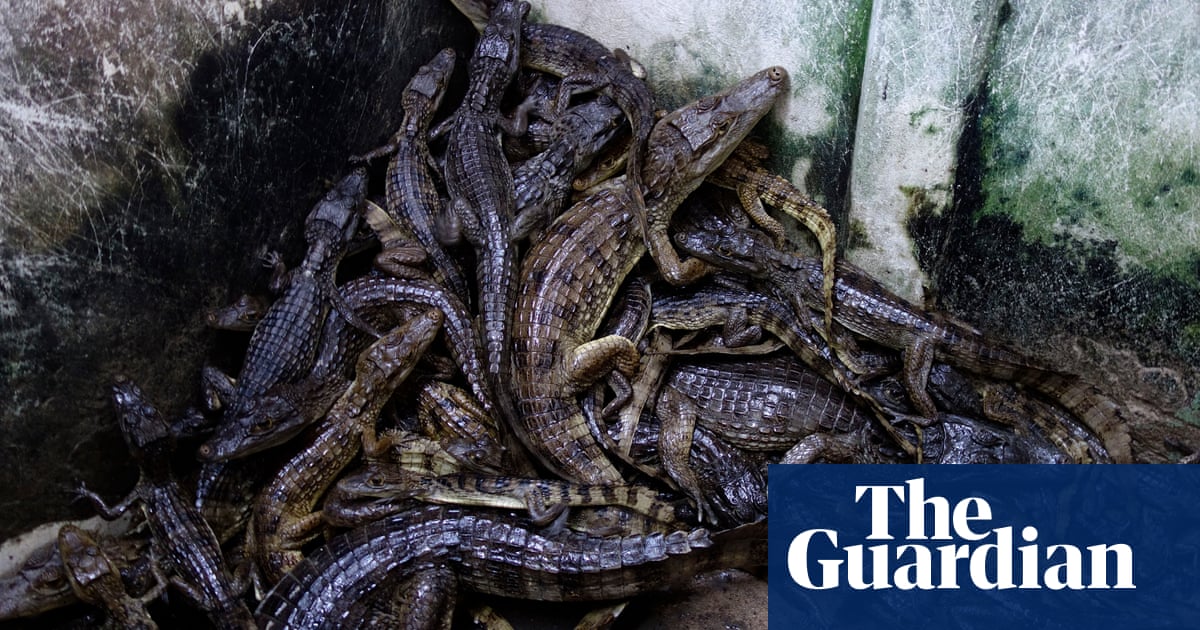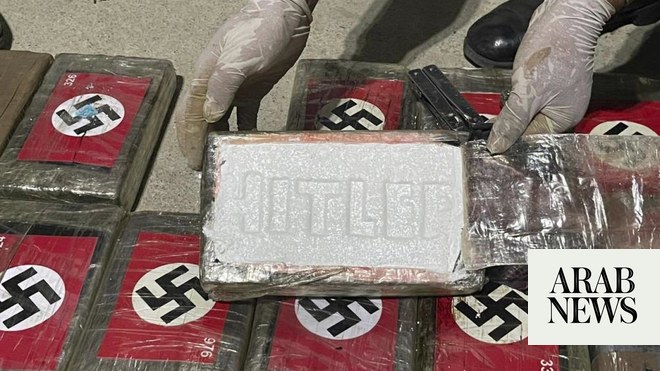
The taskforce sets off from a military base on Colombia’s main river at 2am. The operation has all the hallmarks of a drug raid – it is led by armed police and naval officers and is the culmination of two years of intelligence-gathering in the capital, Bogotá. To avoid tipoffs, only a few of them know who the suspects are.
Today’s contraband, however, is not white powder but the spectacled caiman – the smaller, bulbous-eyed relative of the alligator that is endemic to the wetlands and rivers of South America.
Hoping to catch the suspects while they are still at home, the police navigate a boat down the Magdalena River in total darkness, except for the green hues of fireflies.
“We’ve busted the people who buy from them in smaller quantities: 10, 20, or 50,” says Cristian Mesa, yawning from the exhaustion of a second consecutive night raid. “But we’ve never got the main collection point up river. There are hundreds [of caiman] where we are going.”
From outside, the nondescript house targeted by Mesa’s team in the small, isolated town of Sucre looks like any other. But, after showing their warrants and forcing their way through the front door, the team find a damp pit at the back used as an improvised caiman pool.
Inside the pit are more than 200 of the reptiles poached from local rivers. They huddle in the corners in a heap, making high-pitch squeaks. The largest caiman is a metre long but most are babies. “The younger the better, as the leather will be more supple and thus more valuable when they skin and export them,” says one of the officers, inspecting the huddle.
Colombia’s geography and varied ecosystems mean it is one of the world’s few “megadiverse” countries. Much of the flora and fauna found here is found nowhere else on the planet.
For decades, poachers have plundered the country’s tropical forests, swampy mangroves and vast deserts largely unchallenged, against a backdrop of conflict between communist insurgencies, paramilitaries and the military.
Only now are police beginning to take the issue seriously in the hope of saving animals from extinction and protecting a valuable ecosystem. Five years ago, Colombia’s first intelligence unit dedicated to wildlife crime was founded. Last year the government signed up to the Buckingham Palace declaration, a plan to strengthen defences against wildlife trafficking.
The commitment, backed by Prince William and United For Wildlife, the organisation he created, is a pledge to share intelligence internationally and to train police in how to shut down the underground routes traffickers use to export wildlife. In July, United for Wildlife launched a Latin America and Caribbean chapter.
In Colombia, the programme is already delivering results. Last month, police shut down 40-50 warehouses near Bogotá airport, arresting 15 people and confiscating illegal wildlife valued at $12m (£9m). The Chinese-run operation was sending cryptocurrency to Colombia in exchange for animals from the Amazon rainforest. The investigation was assisted by United for Wildlife’s connections to international banks and crypto-organisations.
“The demand for the illegal wildlife trade is facilitated by intricate criminal syndicates whose networks reach around the globe,” says Rob Campbell, programme manager for United for Wildlife at the Royal Foundation. “The only way to defeat them is through international and cross-sector collaboration, creating a network strong enough to disincentivise the traffickers at every part of the chain, from demand to supply.”
It is a huge task: the northern region of Córdoba where the caimans were confiscated is just one of several wildlife trafficking hubs because of the abundance of birds, reptiles and mammals in its tropical forests, wetlands and lagoons.
The trade in protected animals is a lucrative business. Globally, it is estimated to be worth as much as $23bn a year, the fourth most lucrative illegal industry after drugs, humans and arms.
Traffickers have developed complex networks to get animals across the seas undetected. Pythons from the Amazon are caught and skinned to be sent to China, sharks are netted on the Pacific coast, their fins sliced off and dispatched to Hong Kong, and birds are trapped, caged and shipped in socks to the US.
In Colombia, the police are increasing surveillance efforts and launching more counter-trafficking operations. In 2020, the national unit monitoring trafficking of flora and fauna – where Mesa works – numbered 15, and now employs 80. The teams focus on infiltrating Facebook and WhatsApp groups to find where orders are placed.
About 18,000 birds, animals and reptiles have been confiscated across Colombia so far this year, according to national police figures, while 17,000 were seized in all of 2022.
While the security forces have decades of experience identifying coca labs and camps run by armed rebels deep in the jungle, they have less experience of tracking down wildlife traders.
Colombia is about five times the size of the UK and police efforts are focused mainly on drug wars and other organised crime, leaving most of the country unpoliced for wildlife trafficking.
Like cocaine traffickers, wildlife traders are constantly developing new ways to conceal fauna. “Wildlife trafficking groups are increasingly part of drug trafficking networks, who they learn from. Money from animals often ends up in the hands of cartels,” says Mesa.
When they are not buying off police and forging documents, the traffickers devise often ingenious schemes to transport live animals undetected. In 2016, a group of men known as “the birders” were caught boarding a commercial flight with parrots strapped to their chests. The birds had been sedated and taped to their bodies to avoid detection.
The most common methods are more rudimentary and cruel. Birds are often wrapped in socks with their beaks taped shut and stuffed in cargo boxes sent overseas. “The saddest part is most of them don’t make it alive,” says Mesa.
Angela Maldonado works in the tri-border area of the Amazon where Colombia meets Peru and Brazil, a region from where night monkeys are trafficked abroad to be kept as pets and used for scientific experiments. The area is also a transit corridor for the cocaine trade, with turf wars between Brazilian and Colombian gangs.
“Anything illegal you can imagine is happening in this area,” Maldonado says.
She says only two officers in the region are dedicated to animal trafficking and often the police do not care. “For them, the wildlife trade is not high on the list of things to do when gangs are killing each other. If you mention wildlife trafficking, they will say ‘what are you talking about?’”
The practice is deeply ingrained in local culture and there are often confrontations between police and local people during raids. Many poachers rely on selling sought-after species because they have no other means of bringing in an income. Others are simply looking to capitalise on a lucrative industry.
The day after confiscating the caimans, officers found 260 birds being kept in two houses in Lorica, a small town in Córdoba. Just under half of the brightly coloured species could not be freed as they were injured and featherless from crashing against the sides of 30cm cages.
The two traffickers who were charged for catching and exporting the birds worked as a teacher at the local school and a member of the local mayor’s office. “People here see it just as any other business,” says Maj Ronald Hurtado, who oversees operations in Lorica. “Often, they ask us: ‘why aren’t you out solving real crimes’.”
While Colombia is stepping up efforts to catch the wildlife traffickers, the law has yet to catch up. The maximum prison sentence for trafficking animals is five years but cases are often thrown out by prosecutors. In a country riddled with conflict, crime and human rights abuses for six decades, trading animals is often not seen as a crime worthy of prison time. Local judges can often be swayed with bribes or community connections.
“There is a lack of interest from judges and this also affects police work, as it discourages them,” says Andrea Padilla, a senator and animal rights activist in Bogotá, who is pushing for new animal trafficking laws.
Back in Sucre, the police wrestle with the rescued caimans and place them in burlap sacks with holes punched in the sides. The reptiles will be left outside the office of an environmental organisation, as the animal experts fear being seen with the police by the Gulf Clan, Colombia’s largest drug cartel, which is probably receiving a cut from the trafficking.
“This is not the first time we are here,” says one of the officers, holding open a sack as they slide in the caiman. “This is the fourth time we’ve caught this guy. Hopefully, this time something actually sticks.”












